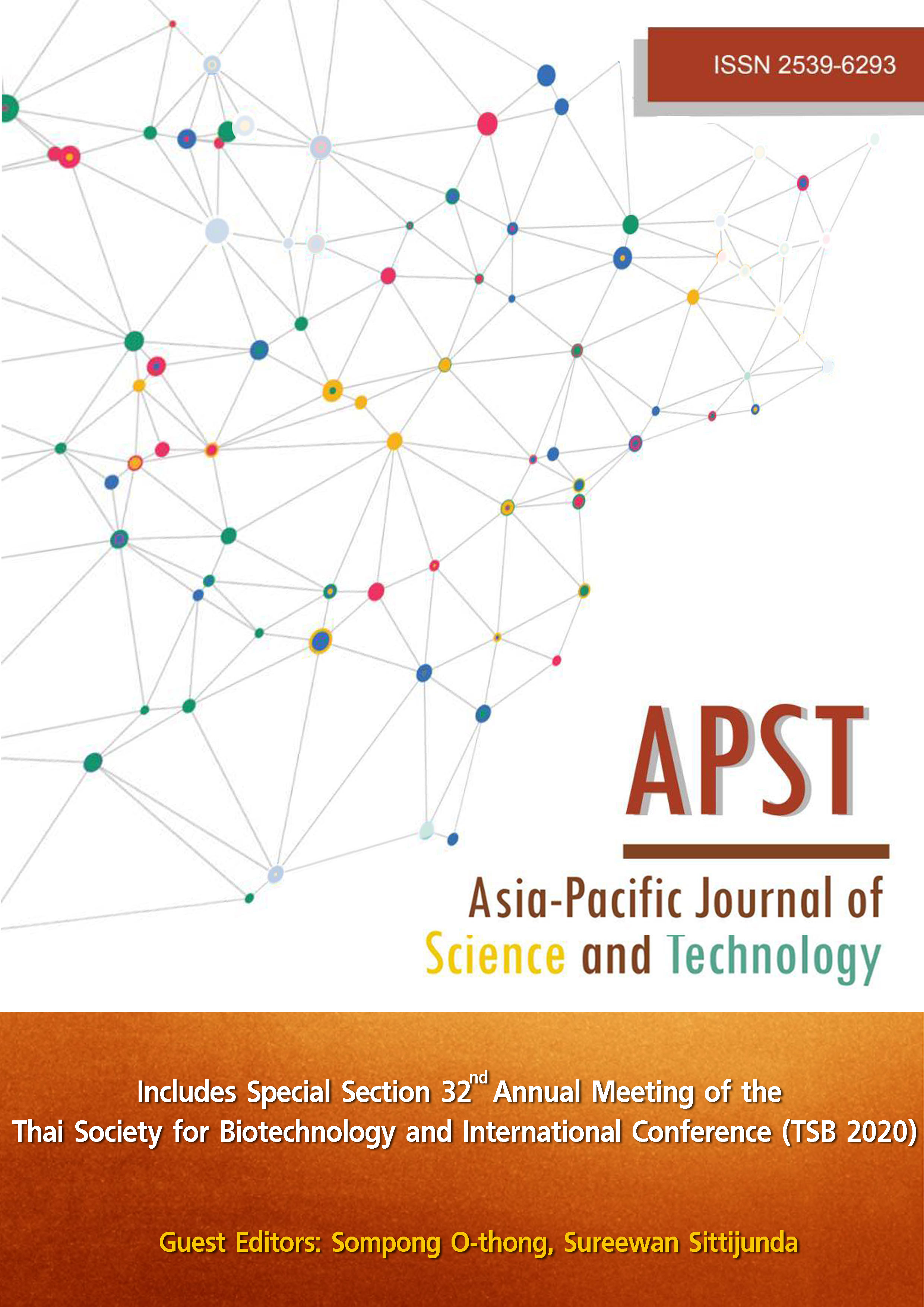A rapid method for selection and cloning of stably transformed insect cell lines
Main Article Content
Abstract
Insect cell lines have been widely used for recombinant protein production due to their abilities in eukaryotic-type post-translationally modifications of proteins and simple culture process. Stably transformed insect cells can be engineered by delivery of the target gene to integrate randomly into the insect cell chromosome, they are then able to stably express this gene and continuously produce recombinant protein. To ensure maximum recombinant protein production, selection of the highest recombinant protein producing cells by cell cloning technique is recommended. A limiting dilution method is generally used for cell cloning, however it is inefficient and time consuming. A rapid cell cloning method for transformed cells selection was therefore developed. A bi-cistronic transfer vector was constructed for gene delivery and co-expression of fusion gene between the target gene, T2A peptides and red fluorescent protein (RFP) encoded genes in insect cells. T2A peptides induce ribosomal skipping during translation thus allowing separation of the target recombinant protein and RFP. Thus, the red florescent cell should be the recombinant protein producing cells and could be easily separated and selected. To validate this vector, an influenza virus neuraminidase gene (NA) was used as a target gene. After 24 hours post transfection, red fluorescent cells were readily observed and selected. Single target cell selection could be achieved within 7-10 days which was 2-3 times more rapid than the original cell cloning process. All cloned cells could stably express the NA gene for at least 22 passages.
Article Details
References
[2] Douris V, Swevers L, Labropoulou V, Andronopoulou E, Georgoussi Z, Iatrou K. Stably transformed insect cell lines: tools for expression of secreted and membrane-anchored proteins and high-throughput screening platforms for drug and insecticide discovery. Adv. Virus Res. 2006;68:113-156.
[3] Yokoyama WM, Christensen M, Santos GD, Miller D, Ho J, Wu T, et al. Production of monoclonal antibodies. Curr Protoc Immunol 2013;102:2.5.1-2.5.29.
[4] Fernandes F, Vidigal J, Dias MM, Prather KL, Coroadinha AS, Teixeira AP, et al. Flipase-mediated cassette exchange in Sf9 insect cells for stable gene expression. Biotechnol Bioeng. 2012;109(11):2836-2844.
[5] Bärtsch S, Würgler FE, Sengstag C. A genetic system to detect mitotic recombination between repeated chromosomal sequences in Drosophila Schneider line 2 cells. Mutat Res. 1997;395(1):9-27.
[6] Zitzmann J, Schreiber C, Eichmann J, Bilz RO, Salzig D, Weidner T, et al. Single-cell cloning enables the selection of more productive Drosophila melanogaster S2 cells for recombinant protein expression. Biotechnol Rep. 2018;19:e00272.
[7] Shaner NC, Steinbach PA, Tsien RY. A guide to choosing fluorescent proteins. Nat Methods. 2005; 2(12):905-909.
[8] Snapp EL. Fluorescent proteins: a cell biologist's user guide. Trends Cell Biol. 2009;19(11):649-655.
[9] Ryan MD, King AMQ, Thomas GP. Cleavage of foot-and-mouth disease virus polyprotein is mediated by residues located within a 19 amino acid sequence. J Gen Virol. 1991;72(11):2727-2732.
[10] Kim JH, Lee S-R, Li L-H, Park H-J, Park J-H, Lee KY, et al. High Cleavage efficiency of a 2A peptide derived from porcine teschovirus-1 in human cell lines, zebrafish and mice. PLoS One. 2011;6(4):e18556.
[11] Donnelly MLL, Hughes LE, Luke G, Mendoza H, Ten Dam E, Gani D, et al. The 'cleavage' activities of foot-and-mouth disease virus 2A site-directed mutants and naturally occurring '2A-like' sequences. J Gen Virol. 2001;82(Pt 5):1027-1041.
[12] Theilmann DA, Stewart S. Molecular analysis of the trans-activating IE-2 gene of Orgyia pseudotsugata multicapsid nuclear polyhedrosis virus. Virology. 1992;187(1):84-96.
[13] Feliciello I, Chinali G. A modified alkaline lysis method for the preparation of highly purified plasmid DNA from Escherichia Coli. Anal Biochem. 1993;212(2):394-401.
[14] Wang W, Douglas D, Zhang J, Kumari S, Enuameh MS, Dai Y, et al. Live-cell imaging and analysis reveal cell phenotypic transition dynamics inherently missing in snapshot data. Sci Adv. 2020; 6(36):eaba9319.
[15] Livet J, Weissman TA, Kang H, Draft RW, Lu J, Bennis RA, et al. Transgenic strategies for combinatorial expression of fluorescent proteins in the nervous system. Nature. 2007;450(7166):56-62.
[16] Lee S-E, Hyun H, Park M-R, Choi Y, Son Y-J, Park Y-G, et al. Production of transgenic pig as an Alzheimer's disease model using a multi-cistronic vector system. PLoS One. 2017;12:e0177933.
[17] Trichas G, Begbie J, Srinivas S. Use of the viral 2A peptide for bicistronic expression in transgenic mice. BMC Biol. 2008;6(1):40.
[18] Ecker JW, Kirchenbaum GA, Pierce SR, Skarlupka AL, Abreu RB, Cooper RE, et al. High-yield expression and purification of recombinant influenza virus proteins from stably-transfected mammalian cell lines. Vaccines. 2020;8(3):462.
[19] Giurgea LT, Morens DM, Taubenberger JK, Memoli MJ. Influenza neuraminidase: a neglected protein and its potential for a better influenza vaccine. Vaccines. 2020;8(3):409.


